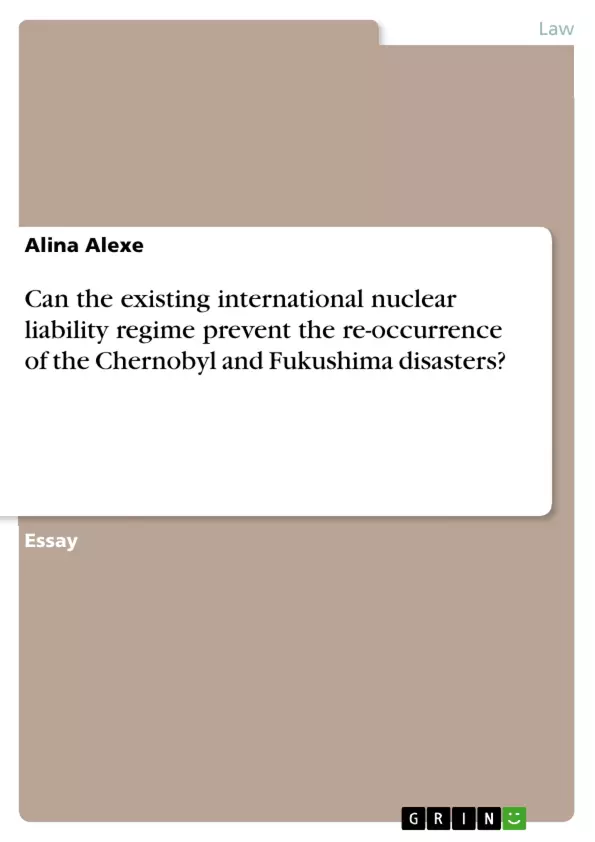In this essay I would like to argue that the existing international nuclear liability framework cannot prevent great nuclear disasters. I will start with some considerations about Chernobyl and Fukushima, and then my discussion will continue with a framework of the international legal provisions that address related clauses of liability. I attempted to furnish plausible interpretation of the existing international legal framework before arriving at conclusion about the efficiency of this framework.
The nuclear accidents of Chernobyl, USSR in 1986 and Fukushima, Japan in 2011 rekindled serious and thought provoking discussions among the scientific communities, policy planners and beneficiaries of the world to understand whether the existing legal liability ensures the nuclear safeguards to the world for continued use of the nuclear technology at the cost of human and environmental tragedies. A thorough review of these two nuclear tragedies in light of legal provisions is made in the subsequent sections to understand [...]
Inhaltsverzeichnis (Table of Contents)
- I. Some considerations about the Chernobyl and Fukushima accidents.
- I.1 Some considerations regarding the Chernobyl accident.
- I.2 Some considerations regarding the Fukushima accident.
- II. Legal framework regarding liability in case of nuclear damage.
- II. Convention on Third Party Liability in the Field of Nuclear Energy (the Paris Convention).
- II.2 The 1963 Brussels Convention Supplementary to the Paris Convention (Brussels Supplementary Convention).
- II.3 Vienna Convention on Civil Liability for Nuclear Damage.
- II.4 The 1988 Joint Protocol Relating to the Application of the Vienna Convention and the Paris Convention.
- II.5 The 1997 Protocol to Amend the Vienna Convention on Civil Liability for Nuclear Damage (VC Protocol).
- II.6 The 1997 Convention on Supplementary Compensation for Nuclear Damage (CSC Supplementary Compensation Convention).
- II.7 The 2004 Protocols to Amend the Paris Convention and the Brussels Supplementary Convention (PC Protocol and BSC Protocol).
- II.7.1 The 2004 Protocol to Amend the Paris Convention (PC Protocol).
- II.7.2 The 2004 Brussels Supplementary Convention (BSC Protocol).
- III. Conclusions.
Zielsetzung und Themenschwerpunkte (Objectives and Key Themes)
This essay aims to examine the effectiveness of the existing international nuclear liability framework in preventing future nuclear disasters similar to Chernobyl and Fukushima. The author explores the framework's capabilities to prevent such events and ensure adequate compensation for victims.
- The limitations of the current international nuclear liability regime in addressing large-scale nuclear accidents.
- The impact of the Chernobyl and Fukushima disasters on the international legal landscape surrounding nuclear liability.
- The challenges of implementing and enforcing international nuclear liability conventions.
- The role of national and international institutions in ensuring nuclear safety and liability.
- The need for a robust and comprehensive international framework to prevent future nuclear disasters.
Zusammenfassung der Kapitel (Chapter Summaries)
The first chapter delves into the Chernobyl and Fukushima accidents, highlighting their devastating consequences and underscoring the need for a comprehensive legal framework to address nuclear liability. The author examines the shortcomings of the existing framework in light of these tragedies.
The second chapter provides a detailed analysis of the international legal framework governing nuclear liability, examining the Paris Convention, the Brussels Supplementary Convention, the Vienna Convention, and subsequent protocols. The author discusses the strengths and weaknesses of each instrument.
Schlüsselwörter (Keywords)
The primary focus of this work is on the international nuclear liability regime, with particular emphasis on the Chernobyl and Fukushima accidents. Key terms include nuclear safety, nuclear liability, international conventions, legal framework, compensation, and prevention.
- Quote paper
- Alina Alexe (Author), 2013, Can the existing international nuclear liability regime prevent the re-occurrence of the Chernobyl and Fukushima disasters?, Munich, GRIN Verlag, https://www.grin.com/document/356134



